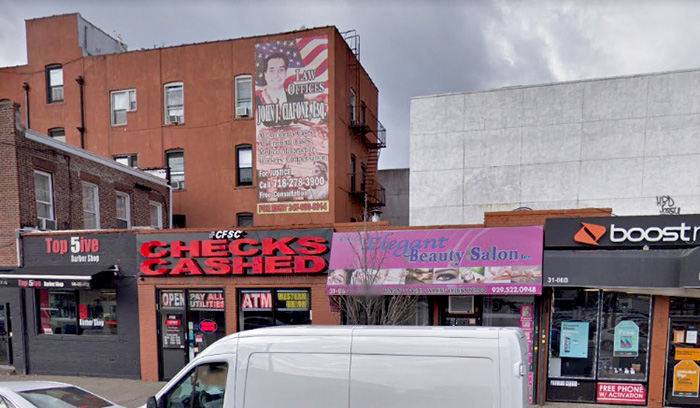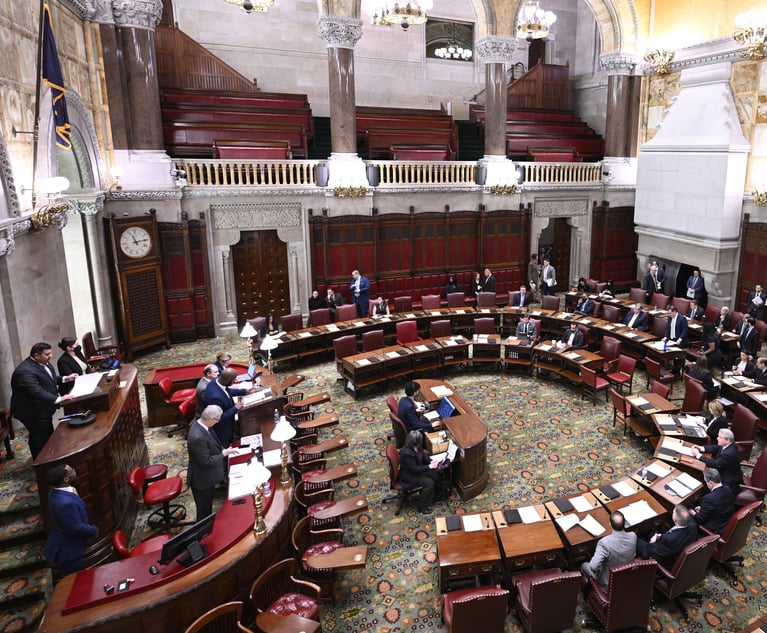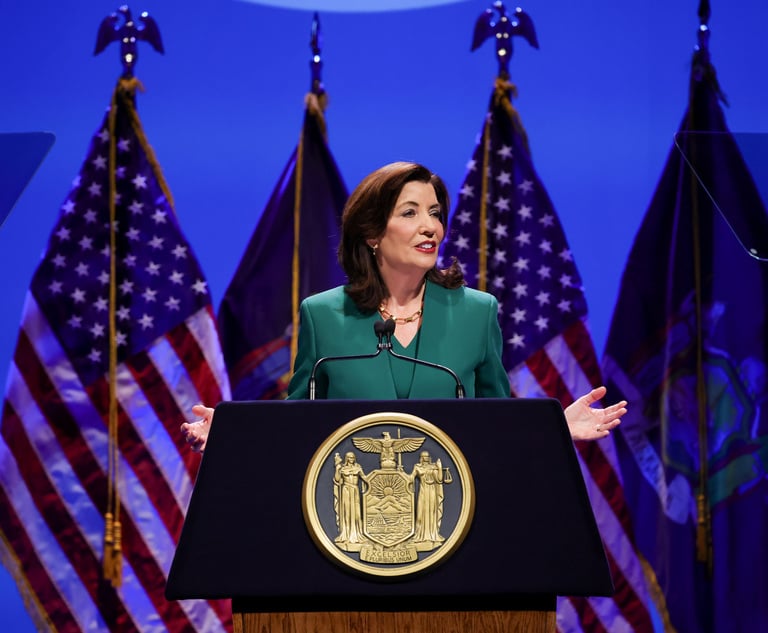Court of Appeals Weighs $380K Fine Over Attorney Ads on Corporate-Owned Buildings
A handful of judges on the New York Court of Appeals appeared skeptical that the attorney, John Ciafone, could escape the fines by showing that he indirectly owned the buildings.
November 19, 2019 at 05:10 PM
6 minute read
 An ad for Law Offices of John J. Ciafone Esq.
An ad for Law Offices of John J. Ciafone Esq.
An attorney from Queens who was indirectly fined $380,000 after he advertised his law practice on buildings he owned through a handful of corporations had his challenge to the penalty heard Tuesday by the New York Court of Appeals, which is set to decide if the fines were justified by law.
A handful of judges on the state's highest court appeared skeptical that the attorney, John Ciafone, could escape the fines by showing that he indirectly owned the buildings.
Ciafone wasn't represented before the Court of Appeals on Tuesday because, despite his direct involvement, he wasn't actually a party in the case. The challenge was brought, instead, by the corporate entities because they were fined by New York City over the signs, not him.
The corporations were represented before the Court of Appeals by Lindsay Garroway, a partner at Cohen, Hochman & Allen in Manhattan.
At issue in the case is a section of the New York City Administrative Code on outdoor advertising companies. The law requires those companies to obtain permits from the city before posting signs that promote the services of another entity.
In this case, that separate entity was Ciafone's law practice. Signs were posted on five buildings in Brooklyn and Queens advertising the Law Offices of John J. Ciafone Esq.
Those five buildings are owned by four corporations, all of which are owned by Ciafone, according to his attorneys.
The New York City Environmental Control Board fined the corporate entities over the signs because, as they argued, Ciafone is not the actual owner of the buildings. The corporations technically own the buildings, the city said.
Garroway argued that the fine imposed over the signs wasn't consistent with what lawmakers in New York City intended when they enacted the law.
"In defining an outdoor advertising company, the New York City Council would have never envisioned fining a small business owner like John Ciafone in the amount of $380,000," Garroway argued.
She challenged the notion that the corporations could be considered outdoor advertising companies based on the text of the law. To qualify as such, those companies have to engage in activities that essentially make space available for advertising.
Associate Judge Leslie Stein was skeptical whether the corporations could escape the label, pointing to a section of the law that says such companies are entitled to offer that space, "or otherwise," make it available.
"That's pretty broad, right?" Stein asked.
Garroway conceded that case law interpreting the statute says "the bar is very low to be considered an outdoor advertising company," but argued that the corporate entities owned by Ciafone align with another case that allowed an individual to escape the city's fines.
In that case, the fines weren't applicable because the owner, Joseph Nativo, was advertising a business that he owned. Nativo, in that case, directly owned the building, rather than through a corporate entity.
Garroway argued that the situation involving Ciafone should be interpreted the same way by the Court of Appeals. While the corporate entities own the buildings, he owns them, she said.
"We're asking for a very narrow exception here," Garroway said.
New York City was represented before the Court of Appeals by assistant corporation Counsel Barbara Graves-Poller. She argued that there was no room for interpretation in the case because the direct owners of the buildings and Ciafone's law practice were not the same.
"He does not own any property at issue in these proceedings," Graves-Poller said. "Mr. Ciafone also doesn't owe New York City one dollar for these violations."
Graves-Poller argued that the Court of Appeals couldn't rationally align Ciafone's case with that of Nativo because the facts were different. Ciafone's corporate entities have no interest in his law practice, she said.
"Petitioners are the owners of the properties, not the individual as Mr. Nativo was in that case, and petitioners do not allege that they have any ownership interest in the advertised entity," Graves-Poller said. "For those two reasons, Nativo is simply not applicable."
Associate Judge Eugene Fahey pushed back on the disconnect alleged by the city between Ciafone and the buildings where his signs were posted. He asked how it would be a burden for the city to determine who the actual owner of the properties was behind the corporations.
"It seems to me something the agency does all the time, and looking behind that form to enforce a whole broad range of building code violations is commonly done by municipalities around the state," Fahey said.
Graves-Poller said the city had determined the ownership of the buildings, but that it was officially the corporate entities, not Ciafone. The fact that Ciafone owned those corporations didn't make a difference, she said.
"The city did find out who owned these properties, and the owners of these properties were the petitioners," she said.
The case is an appeal from the Appellate Division, First Department, which ruled last year that the fines couldn't be avoided by showing that Ciafone owned the buildings through corporate entities. They upheld the penalty in a 3-2 vote.
The two dissenting justices, in that decision, called it "logically absurd" for city officials to leave the fines in place, while an attorney would not be held to such a penalty if they advertised their firm on a building they owned outright.
The Court of Appeals will likely hand down a decision in the case next month.
READ MORE:
Corporate Ownership of Building Put Lawyer Ad Signs in Violation of Billboard Law: Court
N.Y. Court of Appeals Poised To Resolve Split Over Bad Faith Suits Against Insurers
Two Judges Suspended From the Bench, With Pay, by Unanimous NY Court of Appeals
This content has been archived. It is available through our partners, LexisNexis® and Bloomberg Law.
To view this content, please continue to their sites.
Not a Lexis Subscriber?
Subscribe Now
Not a Bloomberg Law Subscriber?
Subscribe Now
NOT FOR REPRINT
© 2025 ALM Global, LLC, All Rights Reserved. Request academic re-use from www.copyright.com. All other uses, submit a request to [email protected]. For more information visit Asset & Logo Licensing.
You Might Like
View All
Relaxing Penalties on Discovery Noncompliance Allows Criminal Cases to Get Decided on Merit
5 minute read
Bipartisan Lawmakers to Hochul Urge Greater Student Loan Forgiveness for Public-Interest Lawyers

'Playing the Clock'?: Hochul Says NY's Discovery Loophole Is to Blame for Wide Dismissal of Criminal Cases

So Who Won? Congestion Pricing Ruling Leaves Both Sides Claiming Victory, Attorneys Seeking Clarification
4 minute readTrending Stories
Who Got The Work
J. Brugh Lower of Gibbons has entered an appearance for industrial equipment supplier Devco Corporation in a pending trademark infringement lawsuit. The suit, accusing the defendant of selling knock-off Graco products, was filed Dec. 18 in New Jersey District Court by Rivkin Radler on behalf of Graco Inc. and Graco Minnesota. The case, assigned to U.S. District Judge Zahid N. Quraishi, is 3:24-cv-11294, Graco Inc. et al v. Devco Corporation.
Who Got The Work
Rebecca Maller-Stein and Kent A. Yalowitz of Arnold & Porter Kaye Scholer have entered their appearances for Hanaco Venture Capital and its executives, Lior Prosor and David Frankel, in a pending securities lawsuit. The action, filed on Dec. 24 in New York Southern District Court by Zell, Aron & Co. on behalf of Goldeneye Advisors, accuses the defendants of negligently and fraudulently managing the plaintiff's $1 million investment. The case, assigned to U.S. District Judge Vernon S. Broderick, is 1:24-cv-09918, Goldeneye Advisors, LLC v. Hanaco Venture Capital, Ltd. et al.
Who Got The Work
Attorneys from A&O Shearman has stepped in as defense counsel for Toronto-Dominion Bank and other defendants in a pending securities class action. The suit, filed Dec. 11 in New York Southern District Court by Bleichmar Fonti & Auld, accuses the defendants of concealing the bank's 'pervasive' deficiencies in regards to its compliance with the Bank Secrecy Act and the quality of its anti-money laundering controls. The case, assigned to U.S. District Judge Arun Subramanian, is 1:24-cv-09445, Gonzalez v. The Toronto-Dominion Bank et al.
Who Got The Work
Crown Castle International, a Pennsylvania company providing shared communications infrastructure, has turned to Luke D. Wolf of Gordon Rees Scully Mansukhani to fend off a pending breach-of-contract lawsuit. The court action, filed Nov. 25 in Michigan Eastern District Court by Hooper Hathaway PC on behalf of The Town Residences LLC, accuses Crown Castle of failing to transfer approximately $30,000 in utility payments from T-Mobile in breach of a roof-top lease and assignment agreement. The case, assigned to U.S. District Judge Susan K. Declercq, is 2:24-cv-13131, The Town Residences LLC v. T-Mobile US, Inc. et al.
Who Got The Work
Wilfred P. Coronato and Daniel M. Schwartz of McCarter & English have stepped in as defense counsel to Electrolux Home Products Inc. in a pending product liability lawsuit. The court action, filed Nov. 26 in New York Eastern District Court by Poulos Lopiccolo PC and Nagel Rice LLP on behalf of David Stern, alleges that the defendant's refrigerators’ drawers and shelving repeatedly break and fall apart within months after purchase. The case, assigned to U.S. District Judge Joan M. Azrack, is 2:24-cv-08204, Stern v. Electrolux Home Products, Inc.
Featured Firms
Law Offices of Gary Martin Hays & Associates, P.C.
(470) 294-1674
Law Offices of Mark E. Salomone
(857) 444-6468
Smith & Hassler
(713) 739-1250






